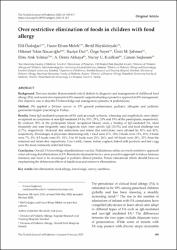| dc.contributor.author | Özdoğan, Elif | |
| dc.contributor.author | Melek, Hacer Efnan | |
| dc.contributor.author | Büyüktiryaki, Betül | |
| dc.contributor.author | Tekin Nacaroğlu, Hikmet | |
| dc.contributor.author | Dut, Raziye | |
| dc.contributor.author | Soyer, Özge | |
| dc.contributor.author | Şahine, Ümit M. | |
| dc.contributor.author | Arık Yılmaz, Ebru | |
| dc.contributor.author | Akkaya, A. Deniz | |
| dc.contributor.author | Kızılkan, Nuray U. | |
| dc.contributor.author | Saçkesen, Cansın | |
| dc.date.accessioned | 2023-03-27T12:46:09Z | |
| dc.date.available | 2023-03-27T12:46:09Z | |
| dc.date.issued | 2021 | en_US |
| dc.identifier.citation | Özdoğan, E., Melek, H. E., Büyüktiryaki, B., Tekin Nacaroğlu, H., Dut, R., Soyer, Ö. ... Saçkesen, C. (2021). Over restrictive elimination of foods in children with foodallergy. Turkish Journal of Pediatrics, 63(1), 109-117. https://dx.doi.org/10.24953/turkjped.2021.01.013 | en_US |
| dc.identifier.issn | 0041-4301 | |
| dc.identifier.issn | 2791-6421 | |
| dc.identifier.uri | https://dx.doi.org/10.24953/turkjped.2021.01.013 | |
| dc.identifier.uri | https://hdl.handle.net/20.500.12511/10714 | |
| dc.description.abstract | Background. Previous studies demonstrated critical deficits in diagnosis and management of childhood foodallergy (FA), and recent developments in FA research support adopting a proactive approach in FA management.Our objective was to describe FA knowledge and management patterns of pediatricians.Method. We applied a 24-item survey to 170 general pediatricians, pediatric allergists and pediatricgastroenterologists practicing in Turkey.Results. Some IgE-mediated symptoms of FA such as cough, urticaria, wheezing and anaphylaxis were falselyrecognized as symptoms of non-IgE-mediated FA by 30%, 29%, 25% and 19% of the participants, respectively.By contrast, 50% of the participants falsely recognized bloody stool, a finding of IgE-mediated FA. Mostfrequently and least frequently used diagnostic tools were specific IgE (30.5%) and oral food challenge test(1.7%), respectively. Maternal diet restrictions and infant diet restrictions were advised by 82% and 82%,respectively. Percentages of physicians eliminating only 1 food were 21%, 19%; 2 foods were 15%, 11%; 3 foodswere 7%, 8%; 4-5 foods were 8%, 11%; 5 to 10 foods were 21%, 26%; and >10 foods were 28%, 25% from thematernal and infant diet, respectively. Cow’s milk, cheese, butter, yoghurt, baked milk products and hen’s eggwere the most commonly restricted items.Conclusion. Overall, FA knowledge of pediatricians was fair. Pediatricians utilize an overly restrictive approachwhen advising diet eliminations in FA. Recent developments favor a more proactive approach to induce immunetolerance and need to be encouraged in pediatric clinical practice. Future educational efforts should focus onemphasizing the deleterious effects of injudicious and extensive eliminations. | en_US |
| dc.language.iso | eng | en_US |
| dc.publisher | Hacettepe Medical Center | en_US |
| dc.rights | info:eu-repo/semantics/openAccess | en_US |
| dc.subject | Diet Elimination | en_US |
| dc.subject | Food Allergy | en_US |
| dc.subject | Knowledge | en_US |
| dc.subject | Survey | en_US |
| dc.subject | Nutrition | en_US |
| dc.title | Over restrictive elimination of foods in children with foodallergy | en_US |
| dc.type | article | en_US |
| dc.relation.ispartof | Turkish Journal of Pediatrics | en_US |
| dc.department | İstanbul Medipol Üniversitesi, Tıp Fakültesi, Dahili Tıp Bilimleri Bölümü, Çocuk Sağlığı ve Hastalıkları Ana Bilim Dalı | en_US |
| dc.authorid | 0000-0003-1333-2648 | en_US |
| dc.identifier.volume | 63 | en_US |
| dc.identifier.issue | 1 | en_US |
| dc.identifier.startpage | 109 | en_US |
| dc.identifier.endpage | 117 | en_US |
| dc.relation.publicationcategory | Makale - Uluslararası Hakemli Dergi - Kurum Öğretim Elemanı | en_US |
| dc.identifier.doi | 10.24953/turkjped.2021.01.013 | en_US |
| dc.institutionauthor | Tekin Nacaroğlu, Hikmet | |
| dc.identifier.trdizinid | 508650 | en_US |
| dc.identifier.pmid | 33686833 | en_US |


















